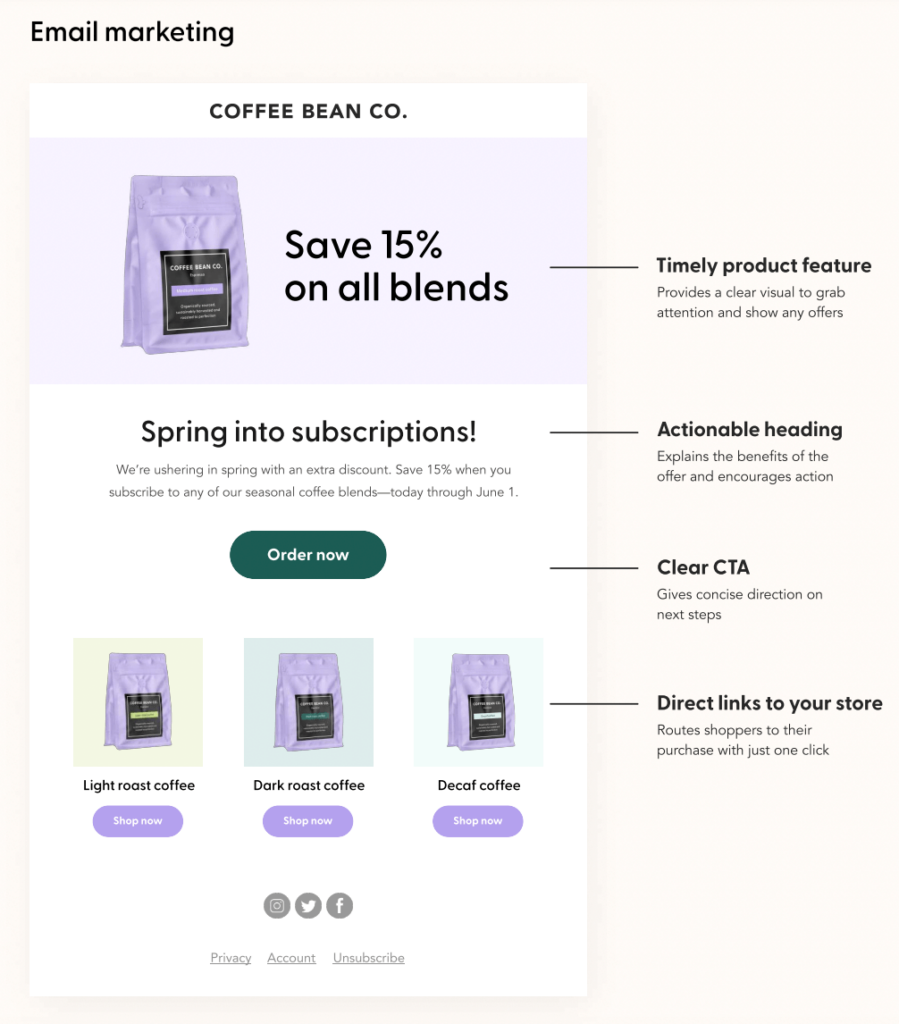When it comes to your digital marketing strategy, your email campaigns should be a primary focus. Through subscribers’ inboxes, email marketers can increase sales, strategically promote certain products, re-engage inactive customers, and more.
Of course, it’s important to strike the right balance with your email efforts. Your emails should be useful to your target audience, easy to understand, intuitive to navigate, compelling to act on, and look and feel like your brand. You’ll also want to send the right volume of emails. Email too often, and you risk pushing away your email recipients; but email too little, and you miss out on a valuable opportunity to engage customers.
To help you navigate the wild world of ecommerce email campaigns, we’ve got tips and best practices to help you design revenue-driving emails.
Key takeaways
- Emails are one of the most important types of marketing materials for ecommerce brands.
- Make sure your emails put your readers’ needs at the forefront, and are clear, engaging, and compelling.
- To increase engagement, be sure to optimize your emails for a mobile audience.
How to ace key elements of your email design
Every marketing email contains several common elements that can be used strategically to boost your products and services. Below, we focus on a few of the most important: subject lines, preview text, product imagery, headings, CTAs (calls to action), body copy, and footer copy.

Impactful subject lines & preview text
Arguably the most important element of any email, your subject line has a huge impact on whether or not your email will be read. In fact, 35% of email recipients open emails based solely on the subject line. Even people who don’t open your email will likely see your subject line, making it a highly visible element.
In as few words as possible, your subject line should capture your target audience’s attention and compel them to want to read more. You only have a few seconds of your readers’ attention here—so make it count. Use action-driven verbs, get to the heart of your value proposition, and avoid words that could be seen as spam.
Preview text, the copy below or next to your subject line, gives your readers further insight into the contents of your email. To make the most of this space, don’t just show the first few lines of copy from the email itself. Instead, support your subject line with complementary details that might compel readers to click. Avoid repeating information you’ve already stated in your subject line, and place the most important details first so that if the text truncates, your readers will still see them.
Compelling product imagery
Your product imagery can help turn your marketing emails into engaging, dynamic content. What’s more, imagery is one of the most powerful opportunities to show, rather than tell, the value of your products or services.
Imagery is one of the most powerful opportunities to show, rather than tell, the value of your products or services.
To make the most of your email images, make sure that any product visuals are both clear and attention-grabbing. For example, if your email campaign is dedicated to promoting a certain seasonal product, use product photography that captures attention while also clearly showing what the item is and how it can be used.
Action-driven headings
Your headings should immediately explain the offer of your email campaign, including its benefits. When possible, it should also encourage action, hinting at details that will be explained in the body copy.
Concise, on-brand body copy
The body copy of your email is your opportunity to go into a bit more detail. While this section should still be as concise as possible, here, you have an opportunity to flex your brand identity and insert your brand voice into your email more fully while also providing more information about your offer.
At the same time, be sure to leave white space (empty space) so as not to overwhelm readers visually with information and text. Make sure the copy you do have is informative, engaging, and looks and feels like you.
Clear CTAs
Your CTAs should provide clear instruction on next steps to take advantage of your offer. These interactive elements should link readers directly to the right landing page of your website while being easily clickable and prominently displayed in the body of your email. When possible, try to limit your CTA to just one to avoid confusing readers about which action you’d like them to take.
Comprehensive footers
Your email footer copy, which comes at the very end of your body copy and after any signatures, is located at the very bottom of your email. This should contain any legally required elements, such as an option to unsubscribe, your company’s address, and information about your privacy policy. Here, you can also add links to your social media, an option to view the copy in your browser, your company logo, and other optional elements.
More best practices for your next email marketing campaign
Looking to create powerful campaigns that are well-read, informative, engaging, and look and feel like your brand? Follow these email marketing strategies for your next campaign.
Automate & personalize
At times, it can be helpful to strategically leverage email templates to make your email production process more efficient. This can be helpful for certain types of campaigns that follow similar patterns, and enables you to not have to start from scratch with every new campaign.
Once you’ve built out your email template, the key is to customize it to fit the needs and nuances of each individual campaign. Make sure that your emails don’t feel redundant, even if they follow a similar structure.
Optimize your reading experience for mobile devices
These days, more and more people are reading emails via their mobile phones—but companies often build out emails with a desktop-first approach. Make sure that your email design is optimized for both a mobile device and desktop computer by considering the following questions:
- Does my email copy cut off earlier on a smaller screen?
- Do the various sections of my email stack properly both on a mobile and desktop view?
- Is the text readable in both formats?
- Do my readers have to scroll much longer on a mobile device vs. a desktop to get to the most essential parts of my email?
Generally speaking, keeping your copy as concise as possible will benefit your mobile readability.
Leverage A/B testing to continually hone your process
Optimizing your emails is a constant process—there’s always more to learn about how your audience behaves and how you can better meet their needs. To maximize your learnings from email campaigns, strategically leverage A/B testing to validate where you should be making updates to your design.
For example, you can A/B test the length and format of your subject lines, the layout of your email, the word count of specific sections or headers, interactive design elements, branding elements like email colors, send times and days, and more.
Putting your readers first
Reaching your customers in their inboxes is a privilege that shouldn’t be taken lightly. Ultimately, the focus of your email design should be to serve your readers, making sure your content is useful, engaging, and clear for them. By following these best practices, you establish your brand as a trusted communicator, opening the door for long-term customer relationships that result in increased customer lifetime value (LTV), brand loyalty, and retention.



